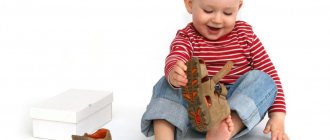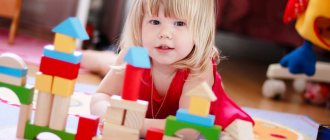Development of object-related activity in young children
Often children, when disassembling a pyramid, put all the rings in order, and then, when collecting it, string it in the reverse order. It is enough to mix the rings together to make the task impossible. In other cases, children achieve success differently: first, they string the rings indiscriminately, and then move them repeatedly until the pyramid becomes “even.”
The most successful at assembling pyramids are those kids who have been specially taught, by placing rings next to each other, to select the largest of them, string it, then select the largest of the remaining ones, etc. From here it is only one step to assembling the pyramid by eye, i.e. that is, to a full-fledged, “adult” way. This means that when teaching children objective actions, adults must show not only their result, but also the method of execution, and a method accessible to children. By mastering objective actions, the child learns what they do with this or that object and how they do it, and he himself learns to perform appropriate actions. In other words, children learn the purpose of objects, ways of operating with them and (within accessible limits) the technique of performing these actions.
Thus,
The child’s objective activity, which arises at the turn of infancy and early childhood, consists of mastering and performing objective actions. It is of key importance for the development of a child in the second or third year of life. In the course of mastering objective actions, the child also masters those mental actions and qualities that are necessary for this. Mastering the use of the simplest tools, the child at the same time gradually begins to assimilate the general principle that one can influence things not only with hands, feet, teeth, but also with things specially created for this purpose.
1. Formation of interest in cooperation with adults in children of the second year of life in the process of manipulative actions.
To establish positive emotional contact with the child, the teacher should perform motor and tactile actions (stroking the child and stroking his eyes, mouth, cheeks with his hands), play games in front of the mirror, “infect” the child with emotions of joy, pick up his counter actions, play games with with the child’s fingers, hands, and feet, using nursery rhymes and short poems; encourage the child to show positive emotions (kissing, hugging, etc.).
2. Formation of orientation towards evaluation of one’s actions by adults (carried out in all classes).
To teach children to act with objects, focusing on the adult’s assessment, manifested in the form of gestures, facial expressions, speech statements (“So”, “Not so”, “Correct”, “Wrong”, “Well done”, “Good”, etc.) ; to form an idea of the final result of the action, it is recommended to encourage the child to perform tasks as shown by the teacher, submitting to his control and evaluation (positive or negative), focusing on the generally accepted result that completes each specific action with the object; with a look, a gesture, a word, look for assessments of the correctness of the action being performed; in cases of difficulties, encourage the child, using gestures or words, to seek help from the teacher; evaluate the actions performed; answer an adult’s questions about the correctness of the action; encourage you to complete the action you have started (independently, with help), transfer learned actions to other situations; create situations in which each subsequent action is possible only if the previous one was performed correctly.
MAGAZINE Preschooler.RF
BASICS OF OBJECT AND GAME ACTIVITY IN PRESCHOOL CHILDRENSubject activity is the leading activity of early childhood. Important new developments in early childhood include the child’s mastery of objective activities. Its prerequisites were formed in infancy.
The transition to object-based activity is associated with the development of a new attitude in the preschooler to the world of objects. Objects begin to appear to him not only as objects convenient for manipulation, but also as things that have a specific purpose and a specific way of use. The discovery of the purpose of objects distinguishes the object-based activity of a young child from the manipulative activity of an infant. The functions of things and objects are revealed to the child by an adult. It is he, the adult, who can provide knowledge about the purpose of objects and show techniques for their use, participating in the child’s activities as an organizer, assistant and senior partner.
An important role in the mastery of objective activity is play activity, which contributes to the fact that objective activity acquires leading status at an early age.
One of these common interpretations is the definition of the psychological concept of “activity” through the concept of “activity” . Since activity and objective activity (as we will try to analyze and prove in further research) are completely irreducible and not deducible from each other, realities and categories, but, at the same time, in psychological works are constantly connected and interdependent, we believe it is necessary to show them meaningful difference and, thereby, justify the limitations of activity and the prospects of substantive activity.
According to the periodization of mental development existing in Russian psychology, objective activity is leading at an early age. In the process of this activity, mastery of socially developed ways of acting with objects occurs.
Tool actions are formed in children gradually; mastering them requires certain efforts from children, since it presupposes a very specific, strictly fixed way of using objects.
Object-tool activity is leading in early childhood, ensuring the development of all aspects of the child’s life.
The influence of objective activity on the mental development of a child. Objective activity contributes to the development of mental processes.
Objective activity also determines the content of the child’s communication with adults.
Within the framework of objective activity, a new type of activity is being formed - a procedural game. The assimilation of socially developed ways of acting with objects is included in the system of human relations, which the child begins to understand in the course of real object-practical interaction with adults.
For children of primary preschool age, completing game tasks brings great pleasure. While playing, the child practices various actions. With the help of adults, he masters new, more complex movements.
At early preschool age, the requirement for mandatory targeted education of motor (physical) qualities is not yet put forward. However, changing game situations and game rules force a small child to move with greater speed in order to catch up with someone, or to quickly hide in a pre-designated place (house, nest) so as not to be caught, deftly overcome elementary obstacles (climb under a rope, without touching them, run between the pins without knocking over any, be sure to run to a certain place, etc.).
Thus, already in early preschool age, outdoor games are a means not only for the development of movements, but also for developing such qualities as dexterity, speed, and endurance.
Outdoor games create an additional opportunity for teacher to communicate with children. The teacher tells and explains to the children the content of the games and their rules. Kids remember new words, their meaning, and learn to act in accordance with instructions.
The activity of children in games depends on a number of conditions: the content of the game, the nature and intensity of the movements in it, the organization and methodology of its implementation, as well as the preparedness of the children.
In the process of play activities, the child acquires communication skills. He learns to take initiative, coordinate his actions, allowing him to maintain communication with his peers. In the future, gaming activities provoke longer communication. In the process of play activities, the child acquires communication skills. He learns to take initiative, coordinate his actions, allowing him to maintain communication with his peers. In the future, gaming activities provoke longer communication. Role-playing games contribute to the development of memory and imagination, and the child also learns to regulate his behavior.
Initially, interest in drawing and design is also associated with play activities, aimed at the process of creating a drawing. Only in middle and older age does the result itself—the drawing—become important for the child. The initial stage of educational activity takes place in close conjunction with play activity.
| Next > |
Consultation for teachers “Object-based activities and play in preschool age”
Object activity and play in preschool age
In connection with the mastery of objective activities, the nature of the child’s orientation in situations that are new to him, when meeting new objects, changes. If during the period of manipulation a child, having received an unfamiliar object, acts with it in all ways known to him, then subsequently his orientation is aimed at finding out what this object is for and how it can be used. Orientation like “what is it?” is replaced by an orientation like “what can be done about this?”
Among the actions that a child masters in early childhood, correlative and instrumental actions are especially significant for his mental development. Correlating are actions whose purpose is to bring two or more objects (or their parts) into certain spatial relationships. This, for example, is folding pyramids from rings, using all sorts of collapsible toys, closing boxes with lids.
By the end of early childhood (in the third year of life), new types of activities begin to take shape, which reach expanded forms beyond this age and begin to determine mental development. This is a game and productive activities (drawing, modeling, designing). During the period of preschool childhood, play becomes the leading activity, but not because the child, as a rule, spends most of his time in games that entertain him; play causes qualitative changes in the child’s psyche. The actual play action will occur when the child means another by one action, and another by one object. The game action is of a familiar (symbolic) nature. It is in play that the formulated sign function of the child’s consciousness is most clearly revealed. Its manifestation in the game has its own characteristics: game substitutes for objects may have significantly less resemblance to the objects themselves than, for example, a drawing with the reality depicted. However, game substitutes should allow you to act with them in the same way as with the replaced item. Therefore, by giving his name to the chosen substitute object and attributing certain properties to it, the child also takes into account some of the features of the substitute object itself. When choosing substitute objects, the preschooler proceeds from the real relationships of the objects. He readily agrees that half a match will be a bear, a whole match will be a mother bear, and a box will be a bed for a bear. But he will never accept this option, where the teddy bear is a box, and the bed is a match.
In play activities, the preschooler not only replaces objects, but also takes on one or another role and begins to act in accordance with this role. A child can take on the role of a horse or a terrible beast, but most often he portrays adults - a mother, a teacher, a driver, a pilot. In play, the child discovers for the first time the relationships that develop between people in the process of work, their rights and responsibilities.
In role play, children reflect the diversity of reality around them. They reproduce scenes from family life, work activities and relationships between adults. The reality reflected in children's games becomes the plot of a role-playing game. Children of different age groups, playing a game with the same plot, bring different content to it. Thus, younger preschoolers repeatedly repeat the same actions with the same objects, reproducing the real actions of adults. The game plot, as well as the game role, is most often not planned by the child of primary preschool age, but arises depending on what object falls into his hands. The content of the role-playing game for older preschoolers is subject to the rules arising from the role taken on.
In play activities, certain forms of communication between children develop. The game requires from the child such qualities as initiative, sociability, and the ability to coordinate his actions with the actions of a group of peers in order to establish and maintain communication.
With the development of gaming skills and the complication of game plans, children begin to engage in longer-term communication. The game itself demands this and promotes this. In playing together, children learn the language of communication, mutual understanding and mutual assistance, and learn to coordinate their actions with the actions of others. Gaming activity influences the formation of arbitrariness of mental processes. Thus, in play, children begin to develop voluntary attention and voluntary memory. Role-playing play is crucial for the development of imagination. In play activities, the child learns to replace some objects with others and take on different roles. By capturing the child and forcing him to obey the rules corresponding to the role he has assumed, the game contributes to the development of feelings and volitional regulation of behavior.
Productive activities of the child - drawing, design - at different stages of preschool childhood are closely merged with play. Interest in drawing and design initially arises precisely as a game, aimed at the process of creating a drawing or design in accordance with the game plan. And only in middle and senior preschool age is interest transferred to the result of the activity (for example, drawing), and it is freed from the influence of the game. Within the gaming activity, educational activity also begins to take shape, which later becomes the leading activity.
Conditions for effective teaching of subject activities
Since objective activity is very important for the development of a child’s personality, his consciousness and thinking, its organization is given a significant place. In order for the process of learning to interact with objects to be effective, the following conditions for its formation must be observed:
- Start with a small number of objects, gradually increasing it and creating conditions for the child to be interested in them, their use and options for actions with them;
- The formation of objective actions should be step-by-step in nature and carried out through direct interaction and cooperation with the child;
- To develop activity, independence, curiosity, and the child’s initiative in performing actions with objects;
- An adult must show tolerance and restraint, not impose his opinion on the child, giving him the opportunity to choose and be active in activities.
Get paid for your student work
Coursework, abstracts or other works





